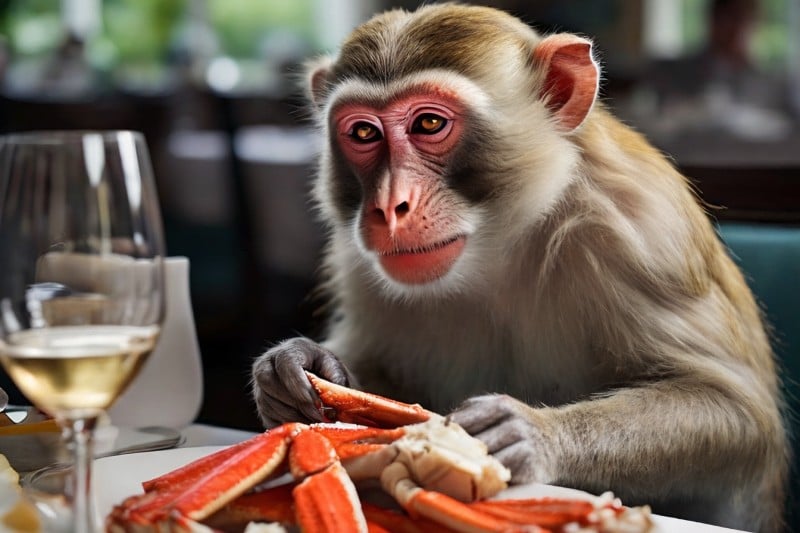A first-of-its-kind study for North America accumulated a list of potential invasive species for the state of Florida, with 40 species determined to pose the greatest threat to residents’ well-being. One species received the highest possible ranking for likelihood of invasion and threat to human health: the crab-eating macaque monkey.
A team of experts, led by Penn State scientist Deah Lieurance, evaluated terrestrial, aquatic and marine species with characteristics making them particularly adept at invasion, totaling 460 vertebrates, invertebrates, algae and plants. The study published on Dec. 14 in the journal Ecosphere.
“The one that wasn’t even on my radar was the macaque,” said Lieurance, who led the project as faculty at the University of Florida and is now an assistant professor of invasive species biology and management at Penn State. “But they’re already in the state in captivity, and as their name says, they’re good at eating crabs. This means they would have an impact on our native biodiversity.”
Lieurance and the working group of experts from academia, state and federal agencies, and non-profits conducted what is known as a horizon scan, systematically examining information to identify emerging issues, opportunities and unknown risks to inform policy and decision-making.
She explained that biological invasions have cost the North American economy $1.26 trillion over the past 50 years, so stopping these invasions before they occur is vital for both ecosystems and the economy. The team focused on Florida because it is one of the main hotspots for invasion in the world and because no horizon scans have ever been conducted for Florida or any other U.S. state.
“Invasive species management tends to be reactive, instead of preventative,” Lieurance said. “This was the reason behind this project: To protect Florida’s natural areas while also saving the money and effort that would go into management strategies.”
Each species evaluated was given a score based on the likelihood of arrival in Florida within the next decade, likelihood of establishment and spread, and their potential ecological, economical and human health impacts. The group of experts then met to form a consensus on ranking the species by risk level. Based on these scoring parameters, the four most likely invaders with the most potential for harm were alewife fish, zebra mussel, crab-eating macaque and red swamp crayfish.
The crab-eating macaque was the only species on that list to rank at the top for likelihood of invasion and risk to human health, due to its close relation to the rhesus macaque, a species already established in Florida and known to carry serious human diseases, including a deadly strain of herpes.
The experts also considered potential pathways that could bring these invaders to Florida, finding that arrival by “escape from confinement” — pet and aquarium releases — was the most likely pathway.
Released or escaping pets are a particularly concerning threat, Lieurance explained, because many of the most detrimental invaders impacting Florida’s ecosystems today were introduced via this pathway, including the Burmese python and the red lionfish.
Lieurance said this research serves as a starting point for future horizon scans, which she suggests should be done every five years or so.
“Now that we have a list, the process next time would involve reviewing what’s there and seeing what new things are coming in, or have the potential to appear,” she said.
But the methods employed for this study are already leading to new approaches nationwide, according to Lieurance.
“A team from the United States Geological Survey took part in this project, evaluating one of the taxonomic groups,” Lieurance explained. “They took their experience back to their superiors and now, at a federal level, the Department of Interior is using bipartisan infrastructure money to fund other horizon scans using this same framework as a part of their National Framework for Early Detection and Rapid Response. This is just one example of how we can already see this project expanding.”
Currently, Lieurance is leading ongoing horizon scan projects for Puerto Rico and the U.S. Virgin Islands, as well.
“As the saying goes, an ounce of prevention is worth a pound of cure,” Lieurance said. “The majority of prevention efforts are initiated when the species has already been detected and often when it’s too late. This project strives to keep concerning species out and truly protect Florida’s biodiversity, unique ecosystems, socioeconomic infrastructure and human well-being.”
The Florida Fish and Wildlife Conservation Commission and the University of Florida Dean for Research funded this study.
Other authors on the study are Susan Canavan, S. Luke Flory, Amy E. Kendig, Sara McCann, Tabitha Petri, Christian Wanamaker, Donald C. Behringer, Kelly Carruthers, Lindsey S. Reisinger, Shirley M. Baker, Lucas Jennings, Basil V. Iannone III, Carey R. Minteer, Eutychus M. Kariuki, Christina M. Romagosa, Kristen E. Bowers, Jeffrey E. Hill, Doria R. Gordon, Lyn A. Gettys and Tolulope Morawo of the University of Florida. Also contributing to the study were Julie L. Lockwood of Rutgers University, Patti J. Anderson of the Florida Department of Agriculture and Consumer Services, Jamie Bojko of Teesside University, Kim Canavan of the University of the Free State in South Africa, Wesley M. Daniel, Cayla R. Morningstar, Matthew Neilson, Ian A. Pfingsten and Robert N. Reed of the U.S. Geological Survey; Jennifer G. Howeth, H. Dail Laughinghouse IV of the U.S. Fish and Wildlife Service, John M. Kunzer of the Florida Fish and Wildlife Conservation Commission, Nicholas E. Mandrak of the University of Toronto Scarborough and Linda J. Walters of the University of Central Florida.
If our reporting has informed or inspired you, please consider making a donation. Every contribution, no matter the size, empowers us to continue delivering accurate, engaging, and trustworthy science and medical news. Independent journalism requires time, effort, and resources—your support ensures we can keep uncovering the stories that matter most to you.
Join us in making knowledge accessible and impactful. Thank you for standing with us!

